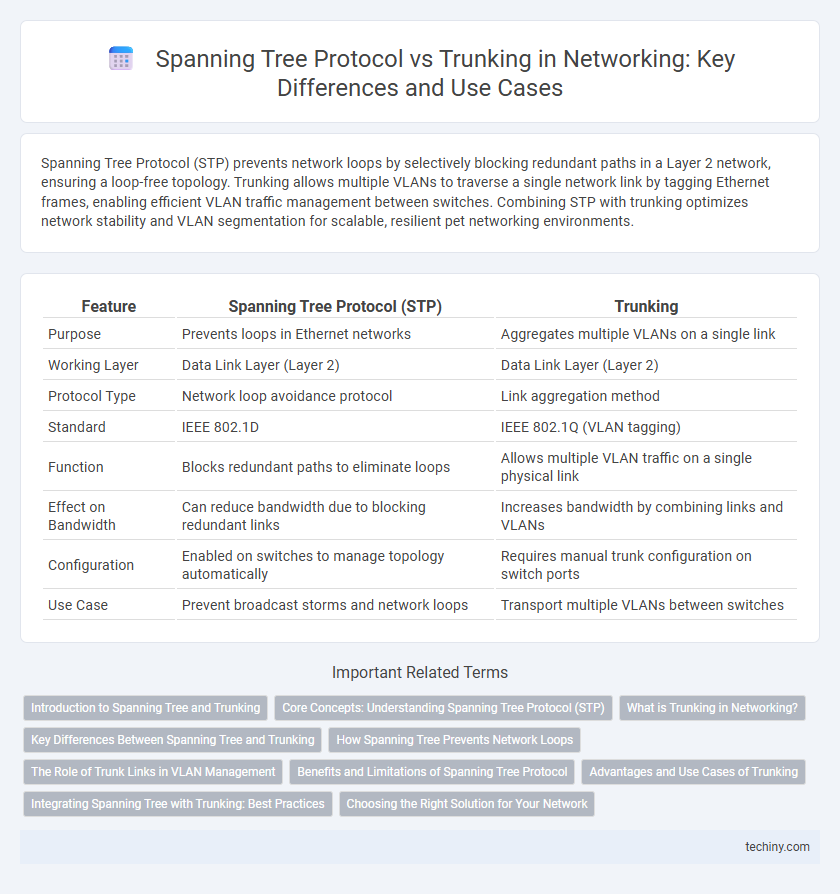Spanning Tree Protocol (STP) prevents network loops by selectively blocking redundant paths in a Layer 2 network, ensuring a loop-free topology. Trunking allows multiple VLANs to traverse a single network link by tagging Ethernet frames, enabling efficient VLAN traffic management between switches. Combining STP with trunking optimizes network stability and VLAN segmentation for scalable, resilient pet networking environments.
Table of Comparison
| Feature | Spanning Tree Protocol (STP) | Trunking |
|---|---|---|
| Purpose | Prevents loops in Ethernet networks | Aggregates multiple VLANs on a single link |
| Working Layer | Data Link Layer (Layer 2) | Data Link Layer (Layer 2) |
| Protocol Type | Network loop avoidance protocol | Link aggregation method |
| Standard | IEEE 802.1D | IEEE 802.1Q (VLAN tagging) |
| Function | Blocks redundant paths to eliminate loops | Allows multiple VLAN traffic on a single physical link |
| Effect on Bandwidth | Can reduce bandwidth due to blocking redundant links | Increases bandwidth by combining links and VLANs |
| Configuration | Enabled on switches to manage topology automatically | Requires manual trunk configuration on switch ports |
| Use Case | Prevent broadcast storms and network loops | Transport multiple VLANs between switches |
Introduction to Spanning Tree and Trunking
Spanning Tree Protocol (STP) prevents network loops by creating a loop-free logical topology in Ethernet networks, ensuring redundant links do not cause broadcast storms. Trunking allows multiple VLANs to traverse a single physical link by tagging frames with VLAN identifiers, optimizing network traffic management and scalability. Both technologies are essential in managing large, complex switched networks to maintain efficiency and prevent connectivity issues.
Core Concepts: Understanding Spanning Tree Protocol (STP)
Spanning Tree Protocol (STP) prevents network loops by dynamically blocking redundant paths in Ethernet networks, ensuring a loop-free topology essential for network stability. It operates by electing a root bridge and calculating the shortest path to the root, disabling redundant links that could cause broadcast storms. Understanding STP's role in managing network topology contrasts with trunking, which aggregates multiple VLANs over a single link to increase bandwidth and maintain VLAN separation.
What is Trunking in Networking?
Trunking in networking refers to the practice of combining multiple network links between switches to increase bandwidth and provide redundancy. It uses protocols such as IEEE 802.1Q to carry multiple VLANs across a single physical link, allowing efficient traffic segmentation and improved network performance. Trunk ports manage tagged frames that enable VLAN identification, ensuring accurate data delivery across interconnected network devices.
Key Differences Between Spanning Tree and Trunking
Spanning Tree Protocol (STP) prevents network loops by creating a loop-free logical topology, while trunking enables multiple VLANs to share a single network link by tagging frames with VLAN identifiers. STP operates at Layer 2 to maintain redundancy and fault tolerance by blocking redundant paths, whereas trunking facilitates VLAN traffic aggregation across switches without loop prevention functions. The key difference lies in STP's role in network stability and loop avoidance, contrasted with trunking's role in VLAN multiplexing and traffic segregation over a single physical connection.
How Spanning Tree Prevents Network Loops
Spanning Tree Protocol (STP) prevents network loops by creating a loop-free logical topology from a physical mesh of interconnected switches, blocking redundant paths while maintaining network redundancy. It elects a root bridge and uses path cost to selectively disable certain switch ports, ensuring data frames do not circulate indefinitely. This loop prevention mechanism enhances network stability and prevents broadcast storms that can degrade network performance.
The Role of Trunk Links in VLAN Management
Trunk links play a crucial role in VLAN management by carrying traffic for multiple VLANs across a single physical link, enabling efficient communication between switches. Unlike spanning tree protocols that prevent loops and ensure network redundancy, trunking specifically facilitates the segregation and propagation of VLAN traffic using tagging mechanisms like IEEE 802.1Q. Implementing trunk links optimizes bandwidth utilization and simplifies VLAN configuration across interconnected switches in large enterprise networks.
Benefits and Limitations of Spanning Tree Protocol
Spanning Tree Protocol (STP) enhances network stability by preventing loops in Ethernet networks through the automatic blocking of redundant paths. It ensures a loop-free topology but can introduce higher latency and slower convergence times compared to other protocols. Despite limitations in scalability and bandwidth utilization, STP remains vital for maintaining network redundancy and avoiding broadcast storms.
Advantages and Use Cases of Trunking
Trunking enables multiple VLANs to transmit over a single physical link, optimizing bandwidth and reducing the number of required ports in network infrastructure. It supports efficient VLAN management across switches, making it ideal for scalable enterprise networks that require segmented traffic and enhanced security. Use cases include data center interconnects and campus networks where maintaining VLAN continuity and minimizing hardware costs are critical.
Integrating Spanning Tree with Trunking: Best Practices
Integrating Spanning Tree Protocol (STP) with trunking requires configuring VLAN trunks correctly by enabling STP per VLAN to prevent network loops and ensure optimal path selection. Best practices include using Rapid Spanning Tree Protocol (RSTP) for faster convergence and setting appropriate bridge priorities to control root bridge placement within VLAN trunk links. Consistent trunk configuration across switches combined with features like BPDU guard enhances network stability and loop prevention in complex VLAN environments.
Choosing the Right Solution for Your Network
Choosing the right solution between Spanning Tree Protocol (STP) and trunking depends on your network's design and requirements; STP prevents loops in redundant Layer 2 topologies while trunking enables multiple VLANs over a single physical link. Networks with a high need for redundancy and loop avoidance benefit from STP, whereas environments requiring VLAN traffic aggregation and segmentation opt for trunking. Evaluating factors like network size, VLAN usage, topology complexity, and traffic patterns ensures optimal performance and scalability.
Spanning Tree vs Trunking Infographic

 techiny.com
techiny.com